Camino de Santiago - French Way - Stage 15 - Castrojeriz to Frómista
Total distance: 24.7 km
To leave Castrojeriz walk down the main street past the Iglesia de San Juan, crossing the road at the fountain and following the way markers taking you towards a gravel track. The path from here, clearly seen up ahead, winds it way up to the top of a hill called the Alto de Mostelares.
About 1 kilometre out of Castrojeriz the track joins a restored section of roman road originally built to provide a solid route across the boggy Odrilla valley. Soon you will come across a wooden footbridge across the Rio Odrilla and then the steep climb up to the Alto de Mostelares. If you look to your right before you start your climb you will see the remains of some old Roman mines where they used to mine for Mica, as you climb you can actually see the seams of Mica.
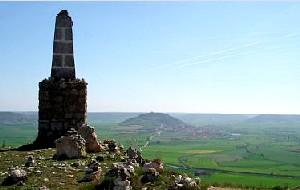
When you get to the top you will see a monument that has supposedly been built by pilgrims. Take some time to rest at the rest area at the top and to take in the view looking back towards Castrojeriz, it's spectacular. Looking ahead, you can see your Camino route stretched out before you towards Puente de Itero, Itero de la Vega and Boadilla del Camino.
From the top follow the iron crosses with yellow plastic on them, these are the way markers. After about 500 metres you will have panoramic views of the valley below. The path begins to descend through some fields for about 3 kilometres at which point, after a slight uphill climb, you will come to the Fuente del Piojo a fountain and picnic area. Take a right along a road and the village of Itero de la Vega can be seen up ahead. The road doesn't actually take you through the village but there is an albergue there if you want to take the slight 700 metre detour off the main road. There are also the remains of the castle that once stood there.
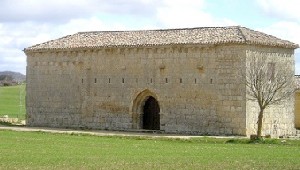
At the crossroads take a left down the road and soon you will come across the Ermita San Nicolás de Bari. This was once a pilgrim hospital that has been converted by the Confraternita dei San Jacopo (the Italian Confraternity of St James) into a refugio. The building doesn't have electricity so if you choose to stay dinner will be served by candlelight.
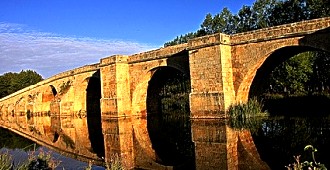
A short walk along the road from the Ermita San Nicolás you will come to the beautiful 11 arched Puente de Itero over the Río Piscuerga. A stone marker at the opposite side of the bridge marks the border between Burgos and Palencia, it also marks the historic border with the kingdom of León. The original bridge was built by Alfonso VI to unify the kingdoms of Castile and León and is mentioned in the Codex Calixtinus.
After you have crossed the bridge take a right down a minor road for about 1.5 kilometres, passing the Ermita de Nuestra Señora de la Piedad and enter the village of Itero de la Vega. There are a couple of shops and supermarket, a bar as well as 2 albergues and a hostel that provide pilgrim menus.
Heading out of the village, follow the white arrows that will take you down a track flanked by water channels on either side. After about 1 kilometre you come across the hamlet of Bodegas, keep walking straight on and cross the bridge over the Canal del Pisuerga. From here the path starts to climb to the top of a hill, you will see them in the distance as 3 humps. At the top of the ridge is the village of Boadilla del Camino. Once you reach the top of the hill the views are fantastic. An unusual sight along this part of the Camino is the number of ornate palomares or dovecotes of all shapes and sizes which dot the landscape. Doves and pigeons are kept mainly for their droppings, which provide good fertilizer, and sometimes provide someone with their dinner.
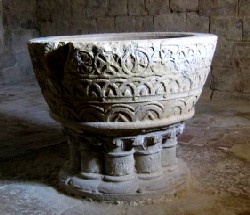
In Boadilla del Camino you can visit the 16th century Iglesia de Santa Maria de la Asuncion which contains an impressive 14th century stone font. If the church is locked you can get the key from the albergue. This is the only remaining church in the village. It did at one time have 3 churches and 2 pilgrim hospitals.
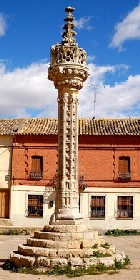
Just outside the church is a 15th century stone cross called the Rollo de Justicia which is the symbol of the jurisdictional autonomy bestowed on the town by King Enrique IV. It is ornately decorated in scallop shells and other Camino related symbols. The Rollo also marks the spot where criminals were tied in chains and subjected to cruel and unusual forms of public humiliation before they were tried.
There are three albergues in the town if you wish to stay here.
Leave the town past the bar and turn left past the football ground and towards the Canal de Castilla. A feat of 18th century engineering the canal was built mainly to transport goods, such as wheat and barley, but with the coming of the railways, like in so many other countries, the canal went into decline and is now used for irrigation for the many wheat fields and provides electricity for the factories. The canal itself is 207 kilometres long starting in the north of Palencia going down to Valladolid.Following the canal towpath for about 3 kilometres you will reach the Frómista Canal lock gates. This lock once had four separate gates allowing boats to descend and ascend the 14.2 metre elevation between the top and the bottom. Cross over the canal here and walk under the railway line into Frómista.
The town of Frómista is perfectly situated in the middle of a rich agricultural region and during Roman times was considered to be the bread basket of the Roman Empire. The Roman's named it Frumentum which is the Latin for cereal.
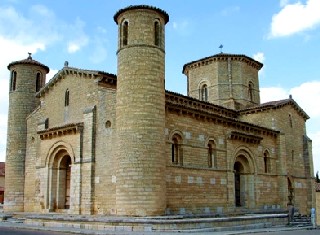
For a small town with a population in the region of 1,400 it is home to two national monuments, the first is the 11th century Iglesia de San Martin de tours. The church had been built originally as part of a Benedictine monastery though no remnants of the monastery exist. Inside the church are more than 300 human and animal faces carved in stone under its eaves. Unfortunately the church is no longer used as a religious building but only as a tourist attraction due to it having been de-consecrated.
The other national monument is that of the Iglesia Santa Maria del Castillo which contains an altarpiece with 29 paintings.
Unusually for a town that is nowhere near the sea, it contains a statue to the patron saint of sea farers, St. Erasmus of Formiae, better known to most English speakers as Saint Elmo. Local legend claims that the Saint was born in Fromista some time in the 3rd century, whether this is true we don't know, but we doubt it.
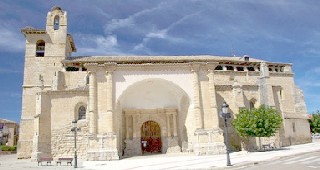
Another church worth visiting is the 15th century Iglesia de San Pedro and its museum of religious art. This is the main parish church of the town.
For those wishing to stay the night there is an albergue and various hotels or hostels to choose from.

